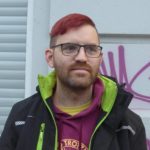First published on The Left Berlin
As I write these lines, I should be at a Kneecap concert. The Irish hiphop group was supposed to play in Berlin on Tuesday night––but the gig was cancelled back in April without explanation. Of course we all know the reason: Kneecap’s German tour was scrapped after they said “Free Palestine” at Coachella.
Instead, they organized 15 sold-out shows across the US––which have all beennixed as well. This because Mo Chara, aka Liam Óg Ó hAnnaidh, has to appear in a London court facing terrorism charges.
It seems quaint now, but does anyone remember when the Right was warning of “cancel culture”? I can’t think of a single right-wing windbag who was actually cancelled. But now we have musicians being persecuted for speaking out against a genocide––and “free speech absolutists” like Elon Musk aren’t interested.
As the Western powers have supported genocide in Gaza, they’ve become more authoritarian at home. They say we need trillions of euros for weapons so they can protect our “freedom” and “way of life.” Meanwhile, they’re beating and arresting people for voicing opposition to government policy.
Mo Chara, Irish for “my friend,” is charged with supporting a proscribed terrorist organization after he draped a yellow Hezbollah flag over his shoulders at a show last year. The Lebanese group has certainly been responsible for violent actions––but so have the Israeli Defense Forces, which are currently carrying out genocide.
As of yet, no one in the UK has faced prosecution for using IDF symbols––and no one has been arrested for joining that particular terrorist group. The term “terrorism” is entirely political: it refers to violent political groups that a government doesn’t like. It can even refer to entirely peaceful groups like Palestine Action, who are guilty of nothing more than civil disobedience.
Who Knows, Really?
While we should have been listening to Kneecap, we were watching videos of other Irish activists. Kitty O’Brien, a 25-year-old, non-binary, Irish Berliner, was punched in the face twice by a black-uniformed cop. Their supposed crime was insulting an officer––and since German law mandates that police use “proportionality” and the “mildest possible means,” this means that nothing short of striking O’Brien’s nose and breaking their arm could have stopped this offense.
Every Irish media outlet took up the story. Within a few days, even the Taoiseach(prime minister) Micheál Martin said he was “deeply concerned” about such “unacceptable” violence.
Yet German media didn’t see what the fuss was about. Tagesspiegel waited a full day to publish a headline with a subjunctive formulation: a police officer “supposedly” punched a woman (sic!) in the face. Spiegel expressed the same uncertainty (though they did later correct the gender in their headline). Both articles acknowledge the numerous videos from different angles––but who knows, really? Maybe the fist stopped a millimeter before O’Brien’s face, whose nose started gushing blood spontaneously at that exact moment.
Germany’s bourgeois journalists are waiting patiently for the police to investigate. Yes, the thugs are supposed to look into their own thuggery. The same ones who clear the perpetrators in over 99 percent of charges.
Germany’s ambassador in Dublin told the Irish Times: “I would like to stress that in Germany, peaceful demonstrations are not suppressed. Freedom of expression is a fundamental right and it is not under question in our democracy in Germany.”
Yet anyone with access to social media can see this is not the case. For two years, Berlin cops have been attacking basic democratic rights, often in violation of court orders. This is just a particularly appalling example caught by numerous cameras.
If You Had the Luck of the Irish
Ireland and Palestine share a history of British colonization, and even a few of the same oppressors: Arthur Balfour, who declared the British government’s support for Zionist colonization of Palestine in 1917, had previously been called “Bloody Balfour” for his violent repression of Irish self-determination.
So it’s no coincidence that Irish people are overrepresented in Berlin’s beleaguered but brave Palestine solidarity movement. The Berlin government tried to deportfour activists––unsuccessfully, for now––and half of them were from Ireland. Berlin cops have banned the Irish language at protests. Even chanting “Saoirse don Phalaistín” (Free Palestine) in front of the Irish embassy is enough to get youarrested.
Liberal politicians claimed that Ireland had finally been pacified by a so-called “peace process,” with Western Europe’s last civil war ended and the legacies of colonialism buried under an intricate system of power-sharing and segregation. Globalization, we were told, would make partition irrelevant.
Yet, Irish opposition to the genocide in Gaza reminds us that the anti-imperialist struggle was never about one particular culture being suppressed. Rather, it is about a handful of capitalist great powers plundering the world and exploiting its people. That’s why it’s the same struggle, from Ireland to Palestine to Berlin.
In a video, you can hear Comrade Kitty telling those cops: “You don’t fucking scare us!” The German media might try to ignore police violence in Berlin, just like they ignore genocide in Gaza. But the whole world saw that punch––and everyone is trying to get tickets to Kneecap.

